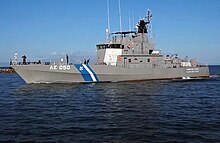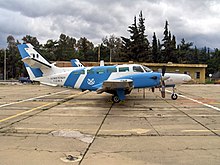|
Hellenic Coast Guard
The Hellenic Coast Guard (Greek: Λιμενικό Σώμα-Ελληνική Ακτοφυλακή, romanized: Limeniko Soma-Elliniki Aktofylaki, lit. 'Harbor Corps-Hellenic Coast Guard') is the national coast guard of Greece. Like many other coast guards, it is a paramilitary organization that can support the Hellenic Navy in wartime, but resides under separate civilian control in times of peace. The officers and the enlisted members of the Coast Guard are regarded as military personnel under Military's Penal Code.[2] It was founded in 1919 by an Act of Parliament (Law No. 1753–1919) and the legal framework for its function was reformed in 1927. Its primary mission is the enforcement of Greek, European and International law in the maritime areas.[3] Historically, it is very closely associated with the Greek shipping industry; many Coast Guard officers retire early to find employment in Greek and international companies owned by Greek ship-owners.[4] Role and responsibilitiesThe main activities of the Hellenic Coast Guard are defined in the present legislation and specified within its institutional framework of operation. These activities are the following:[1][3]
In order to perform these roles, the Coast Guard operate a number of patrol boats of various sizes (6m to 60m) and different types (RIBs, coastal patrol boats, offshore patrol boats, lifeboats and pollution control vessels).[6] On land the Hellenic Coast Guard is equipped with 634 vehicles, including patrol vehicles, cars and motorcycles, buses and mini vans, trucks and tanker.[7] The Coast Guard also operate seven airplanes and six helicopters.[8] Organization The Hellenic Coast Guard is under the authority of the Ministry of Shipping and Island Policy,[9] which is headed by a commandant and assisted by two deputy commandants who all have the rank of vice admiral (Antinavarchos). As of 2022[update], Georgios Alexandrakis serves as Commandant of the Hellenic Coast Guard..[10] The Hellenic Coast Guard operates the Maritime Rescue Coordination Center (MRCC) in Piraeus and the Emergency Radio Communications Station SXE at Aspropyrgos (38°02′12.5″N 23°35′7.5″E / 38.036806°N 23.585417°E). The Hellenic Coast Guard also operates the Vessel Traffic Service (V.T.M.I.S.) at busy sea lanes, currently around the ports of Piraeus, Elefsis, Lavrion and Rafina. Between May 21, 1964, and 1980 the Hellenic Coast Guard had its own special flag, which was derived from the Greek Ensign with the addition of the crossed anchors badge on the center of the white cross. PersonnelMost officers in recent years are graduates from higher education establishments, including the Merchant Marine Academies. After recruitment new officers study for four years at the Hellenic Naval Academy. Petty officers are trained for two years at Palaskas Naval Training Centre and lower rank enlisted men are trained at Scholi Limenofylakon (Greek: Σχολή Λιμενoφυλάκων, romanized: Sxoli Limenofilakon) at Piraeus, for a duration of two years. With law Law 4029 of 2011, a volunteer Auxiliary Coast Guard was established.[11] The Officers of the Hellenic Coast Guard have the same ranks as the Officers of the Hellenic Navy and similar insignia, replacing the curl with two crossed anchors. The Petty Officers (Ratings) also use rank insignia similar to those of the Hellenic Navy, replacing the speciality symbol with the crossed anchors badge.[12] Ranks and insigniaCommissioned officers
NCOs and enlisted
FleetAs of 2015, the structure of the Hellenic Coast Guard consists of a fleet of five Offshore Patrol Vessels (OPVs) sized 45–60 metres in length and of 300-450 tons displacement, six to twelve Patrol boats with lengths of 25–30 meters, and more than fifty Coastal Patrol Vessels of various types with lengths of 14–20 meters.[13][14] In addition, the Hellenic Coast Guard operates a large number of fast Rigid-Inflatable Boat (RIB)/Special Forces vessels as well as eleven Lifeboats. Currently, the Hellenic Coast Guard fleet in its totality consists of approximately 240-250 vessels of all types.[15][16] In August 2023, the Hellenic Coast Guard ordered 31 Munin S1200 patrol boats and three Metis high-speed RHIBs.[17] Five Finnish-built fast patrol boats "Watercat 2000 Patrol" were ordered in early November 2023.[18]
Aircraft fleetThe Hellenic Coast Guard operates a small fleet of fixed wing aircraft based at Tatoi (Dekelia) Air Base, (LGTT, 38°06′35.1″N 23°46′55.5″E / 38.109750°N 23.782083°E).
HCG facilities
References
External linksWikimedia Commons has media related to Hellenic Coast Guard. |
|||||||||||||||||||||||||||||||||||||||||||||||||||||||||||||||||||||||||||||||||||||||||||||||||||||||||||||||||||||||||||||||||||||||||||||||||||||||||||||||||||||||||||||||||||||||||||||||||||||||||||||||||||||||||||||||||||||||||||||||||||||||||||||||||||||||||||||||||||||||||||||||||||||||||||||||||||||||||||||||||||||||||||||||||||||||||||||||||||||||||||||||||||||||||||||||||||||||||||||||||||||||||||||||||||||||||||||||||||||||||||||||||||||||||||||||||||||||||||||||||||||||||||||||||||||||||||||||||||||||||||||||||||||||||||||||||||||||||||||||||||||||||||||||||||||||||||||||||||||||||||||||||||||||||||||||||||||||||||||||||||||||||||||||||||||||||



































